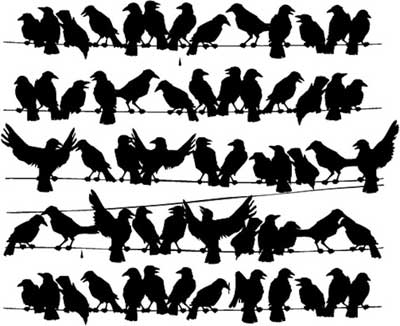
|
Did you hear the thing about the Florida woman who implanted a third breast in order to be "unattractive to men"? The one who is filming "her daily life in Tampa to show the struggles she faces because of her surgery"? She didn't, and she is not. The whole thing—for better or for worse—was a hoax. The Internet moves quickly. Rumors emerge, intentionally and not; they spread, intentionally and not. There's a reason, of course, that "wildfire" is such a common metaphor when it comes to describing this stuff: Rumors, once sparked, don't just spread extremely quickly; they are also extremely difficult to contain. And on top of everything else, it is extremely hard to predict which direction they'll take as they spread. Enter Emergent.info. The site, launched today after two months of testing and data-gathering, is hoping to change that by tracking rumors that arise in (pretty much) real time. As Craig Silverman, the rumor researcher who created the site, told me: "It's aiming to be a real-time monitoring of claims that are emerging in the press." Emergent.info works through a combination of human and algorithmic processing. Silverman and a research assistant find rumors that are being reported in the mainstream media—most often, stories that bubble up through social media and get spotted by one outlet … and then, from there, picked up by other outlets. Then they search Google News, which aggregates various news outlets' take on the story. They gather those stories and enter them into their database, classifying them according to the outlet and to how each of the outlets is reporting them. Some will report rumors not as rumors, but rather as simply true or simply false; the majority, however, simply report the fact that they have heard them. Often they'll hedge that repetition with caveats like "Sources:" or "Rumor:" or "Unconfirmed:" in headlines or texts. Just as often, however, they'll be more subtle in their warnings. In the case of the Tri-Breasted Lady, many places simply repeated the rumor as fact, their main additional caveat being a well-placed "WTF." Then their algorithm takes over. Emergent.info is essentially a web app, built on an API from the back-end database. (You can think of it as something of a data-driven version of Snopes—with a more expansive premise. "Snopes, they're amazing," Silverman says, "but they only do Snopes work; they don't aggregate what other people are doing. This site is able to identify claims and then actually see, okay, who's got the best information about it?") Every hour, Emergent.info's script crawls the stories to see whether their text has changed. The system also checks share counts to monitor how stories are moving through the social media ecosystem. All of which, Silverman says, helps to answer questions that haven't been so systematically analyzed before. Among them: "What's the life cycle of a rumor in the press now? And how are news organizations dealing with things that are unconfirmed? And are they updating the stories, and are they sticking with it over time?" Take the reports—false reports, it turns out—that Durex is making a pumpkin-spice condom: Through Emergent.info, you can see who repeated the rumor, who checked it, and who debunked it. Or take, more seriously, the stories that emerged last week claiming that a meteorite had landed in Nicaragua. (That rumor is still listed as unverified on Emergent.info, because no one has been able to prove that such a meteorite actually fell.) A challenge news organizations face when it comes to rumor-reporting in particular is the fact that rumors tend to be much more shareable—and much more clickable—than corrections. Take your friend and mine, Ms. Tampa Triple-Breast (self-given pseudonym: Jasmine Tridevil). One of the early stories about her, in the New York Post, got 40,000 shares. The Snopes article (mostly) debunking the initial story had 12,500 shares—a decent amount for a story that is, technically, a non-story. For the most part, though, the articles debunking the rumor get extremely little attention. (For a more crystalline example of all that, you can look to Buzzfeed's coverage of the story. Its initial story got more than 30,000 shares; its debunking of that story got just over 1,000.) Which means that news organizations often have very little incentive—direct, commercial incentive, at least—to put their time and energy into them. As a result, as Silverman puts it: The Total Recall rumor is "a story that, I would argue, the average person probably doesn't know is not true." The larger problem with all that is that rumors, once they're put out there into the maw of the media, are notoriously hard to correct. There's the fact that "sorry, just kidding about that three-boobed lady thing" is nowhere near as sharable as a "whoa, three-boobed lady!" thing in the first place. But there's also the fact that there is very little uniformity among media outlets about how updates, corrections, retractions, and the like should be presented to readers. Most outlets will simply update a story that contains a debunked claim; a few will write new stories altogether, linking to the previous one in the process. That can leave readers, however, in a kind of epistemological limbo: You're never quite sure what's been verified and what has not. Trust is a precious resource in journalism; many outlets haven't fully figured out how to preserve it. "So much of this stuff is public before news organizations get to it," Silverman points out. "So that's a very different dynamic from what used to happen. So if something is by default public, how do you decide when you're doing to point at it in a way that's responsible? And then how do you deal with it as it sort of takes its life path to being true or false?" Bringing some data to bear on those questions, he's hoping, will help news outlets start to answer them. |
据《大西洋月刊》杂志网站报道,你听说过那个有三个乳房的佛罗里达州女人吗?那个为了让自己“在男人面前没有吸引力”而去移植第三个乳房,还拍摄了自己“在坦帕市(Tampa)的日常生活,及由于手术而遭受的各种挣扎”录像的女人——你听说过没? 她没有做过那种手术,她也没有第三个乳房。整件事不论怎样——是一场骗局。 网上消息传播快。不论有无意,谣言空穴起;不论有无心,谣言传千里。这当然有原因,“野火”是形容这种事的常用隐喻:谣言,一旦被点燃,不仅流传极快,而且极难控制。不过最可怕的是,我们极难预知谣言会往哪个方向发展。 登录Emergent.info网站。经过两个月的测试和收集数据,这个网站于9月28日正式启用,希望通过追踪流言产生的(接近)真实时间,改变流言四起的困境。网站创立者,谣言研究员克雷格•西尔弗曼(Craig Silverman)告诉我:“网站致力于实时监测媒体中产生的各种言论。” 在比较广大的前提下,你可以把它当作数据驱动版的Snopes(美国一家专门核查并揭穿谣言和传闻的网站)。 Emergent.info网站通过人工处理和算法处理相结合来运作。西尔弗曼和一位研究助理发现,那些被主流媒体报道的谣言大多最早只是在社交媒体中冒了个泡,而后被某个渠道发现……然后以此为中转,被其他渠道获取了消息。他们随后搜索了谷歌新闻,这里聚集各类新闻渠道对消息的报道。他们将这些报道收集编入数据库,并以其渠道来源和报道方式进行分类。有的报道不把谣言当谣言,而是进行了简单的真或假区分;不过大部分报道仅仅告诉读者有这么个传言。通常标题或正文中会用一些像“来源”,“传言”,或“未确认”之类的标注来避免重复。然而,往往报道中的警告会更加微妙。在“三乳女子”事件中,许多媒体仅仅将谣言当作事实重复,它们的主要附加警告便是一个方便顺手的“WTF.” 他们的计算机算法接手了这种状况。Emergent.info实质是一个网页应用,建立于一个后端数据库的应用程序界面(API)。(在比较广大的前提下,你可以把它当作数据驱动版的Snopes。“Snopes非常棒。”西尔弗曼表示,“但是它也有局限,它无法收集其他人正在做什么的信息。这个网站能够识别各种言论,然后切实发现是谁掌握了消息的最可靠信息。”)每隔一小时,Emergent.info的脚本程序就会监测消息的文字是否发生改变。这个系统还检查消息被分享的次数,以此监控信息在社交媒体生态系统中是如何移动的。 所有这些,西尔弗曼表示,有助于回答不少此前从未被系统分析过的问题。其中包括:“谣言在新闻界的生命周期是什么样的?新闻机构如何处理未经确定的消息?报道是否有及时更新,或是一直不变?” 拿那些报道——假报道为例,竟有“杜蕾斯(Durex)推出南瓜香型的安全套”的消息:通过Emergent.info,你可以分别知道是谁散布、遏制以及揭穿了谣言。或者以较严肃的报道为例,上周有数篇报道称有一颗陨石坠落于尼加瓜拉。(这则谣言依然在列于Emergent.info的未经证实列表中,因为无人可以证明确有这么一颗陨石坠落。) 新闻机构尤其在报道谣言时会面临一个挑战:谣言比辟谣更容易被分享——也更容易吸引点击。以大家都熟悉的“坦帕市三乳女士”为例(她给自己造了假名字:茉莉•三乳恶魔(Jasmine Tridevil))。早期一篇《纽约邮报》(New York Post)关于她的报道被分享了4万次。而Snopes发表的(主要)拆穿初期报道的文章仅1.25万次分享——这对于一篇从技术层面上不算报道的报道来说,也相当可观。 “三乳妖妇,纯属恶搞”报道远不及“亮瞎!惊现三乳妖妇”报道来得吸睛。 然而大多情况下,辟谣的文章总是乏人问津。(举个最清楚透明的例子,你可以查看在新闻聚合网站Buzzfeed对那个新闻的报道。首篇文章被分享逾3万次;而辟谣文章仅1万余次。)这意味着新闻机构缺乏足够的激励——直接的商业激励,懒得把时间和精力放在辟谣上。结果如西尔弗曼所说的:电影《全面回忆》(Total Recall)的谣言就是“一个我敢说大多数人都信以为真的故事”。 更大的问题在于,谣言一经媒体的轮番反刍,便人尽皆知,难以澄清。最近的例子就是“抱歉,三乳妖妇,纯属恶搞”的分享量远不及“亮瞎!惊现三乳妖妇”。不仅如此,各媒体渠道在如何向读者更新、澄清、撤回文章等问题上缺乏默契。大多数媒体仅简单更新一篇辟谣声明的报道;鲜有媒体会集中重新报道,并提供先前文章的链接。如此便给读者留下了认识上的不安定状态:你总是无法确定什么是已经证实的事实,什么是无凭无据的谣言。信任是新闻业的宝贵资源,但许多媒体还不知道要如何保护它。 “这些东西不少在经手媒体之前就已经众人皆知,”西尔弗曼指出,“所以这是一种与以往极为不同的动力。因此,如果面对一桩已经公众化的事情,你决定以怎样负责任的方式处理?如果它正沿着其或真或假的轨道发展,你又该如何处置?”就此,西尔弗曼收集了一些数据,他希望可以借此帮助新闻机构回答这些问题。 扫一扫,关注微博微信
  (译者 海船果心 编辑 Julie) |
|
|
